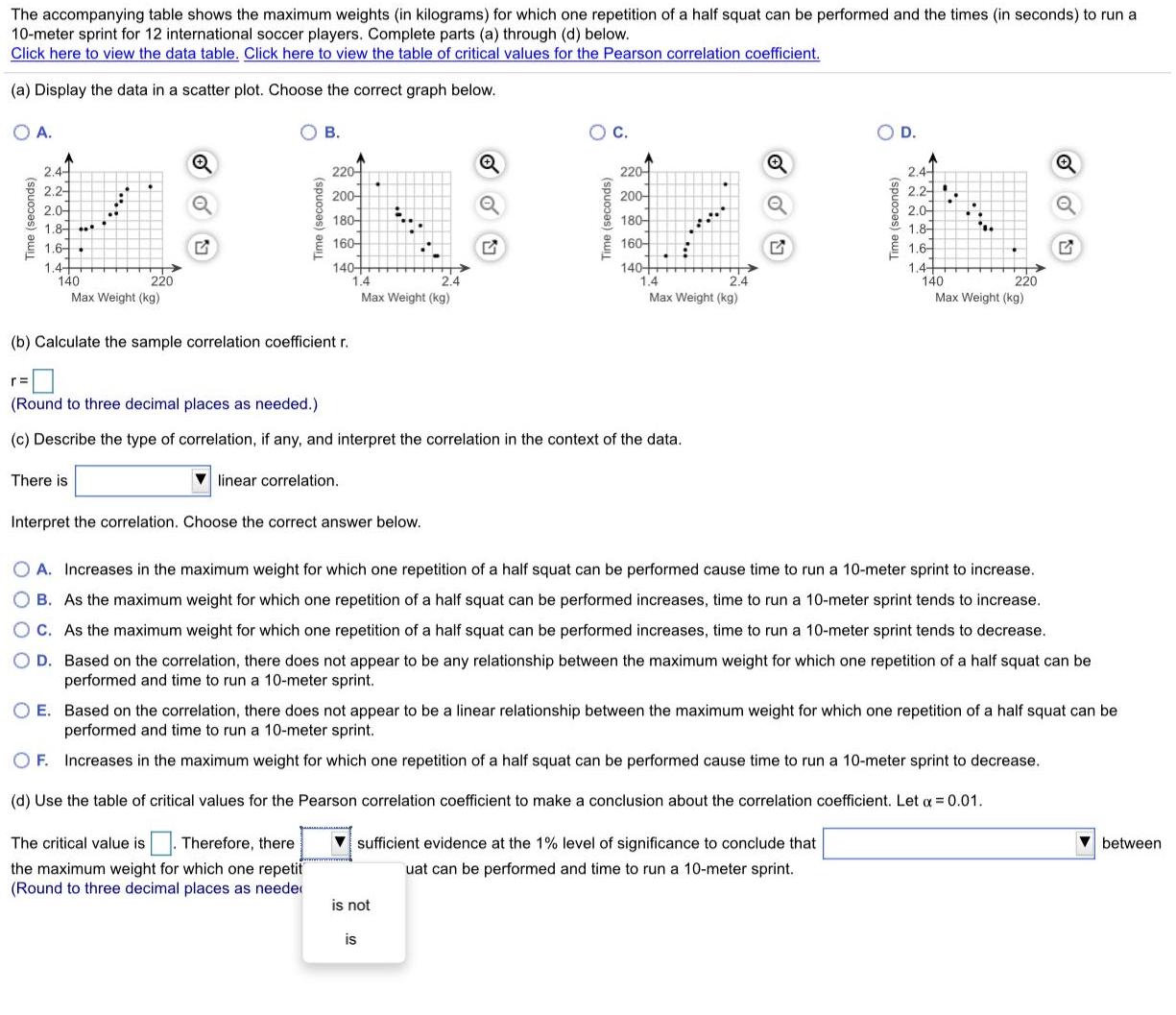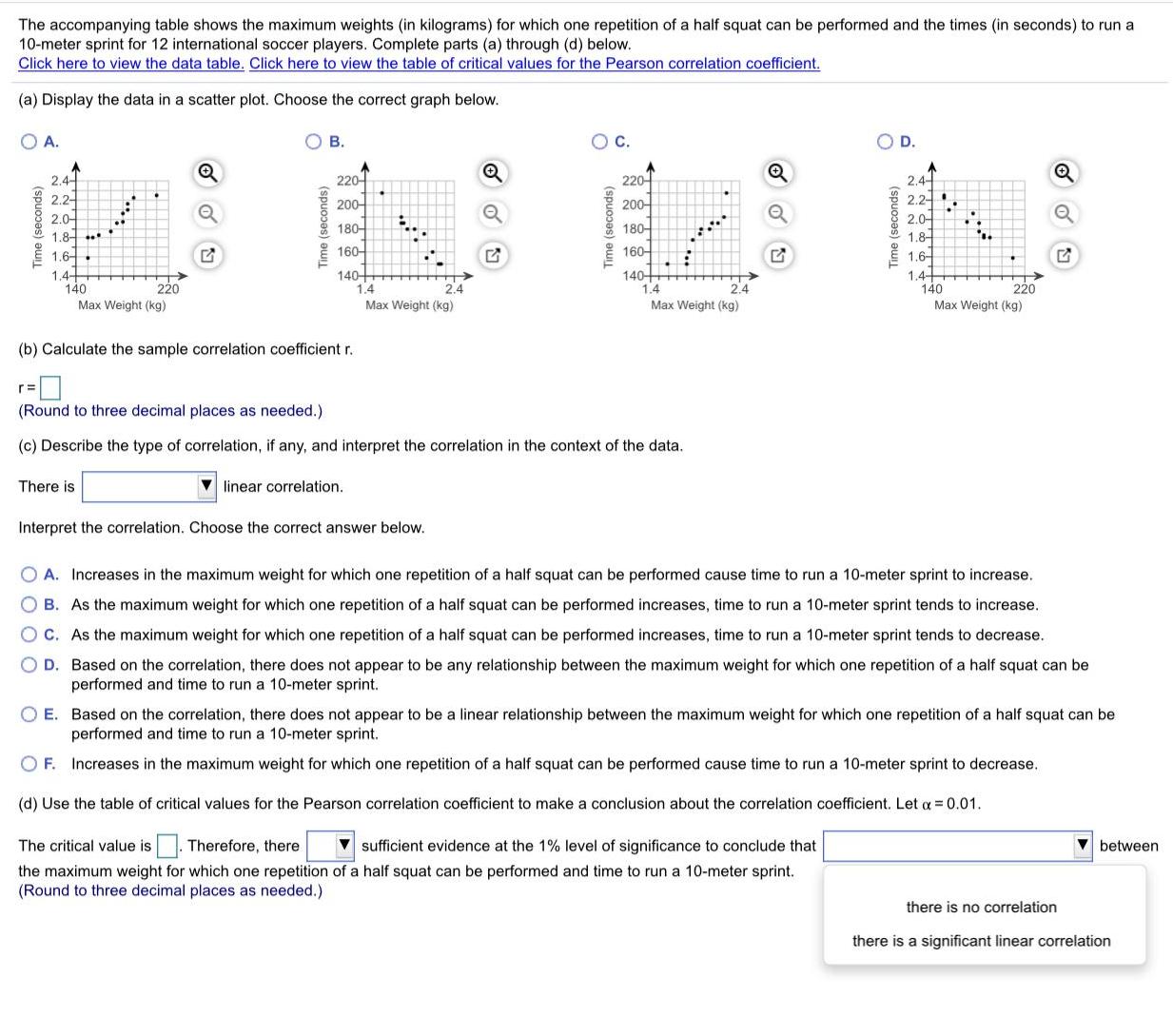Answered step by step
Verified Expert Solution
Question
1 Approved Answer
The accompanying table shows the maximum weights (in kilograms) for which one repetition of a half squat can be performed and the times (in



The accompanying table shows the maximum weights (in kilograms) for which one repetition of a half squat can be performed and the times (in seconds) to run a 10-meter sprint for 12 international soccer players. Complete parts (a) through (d) below. Click here to view the data table. Click here to view the table of critical values for the Pearson correlation coefficient. (a) Display the data in a scatter plot. Choose the correct graph below. O A. . . D. 2.4- 2.2- 2.0- 1.8- 2.4- 220- 220 2.2- 200- 200- 2.0- 180- 180- 1.8- .* 160- 160- 1.6- 1.4 140 Max Weight (kg) 1.6- 1.4 140 Max Weight (kg) 140- 1.4 140+ 1.4 220 2.4 Max Weight (kg) 2.4 220 Max Weight (kg) (b) Calculate the sample correlation coefficient r. (Round to three decimal places as needed.) (c) Describe the type of correlation, if any, and interpret the correlation in the context of the data. There is V linear correlation. Interprett correct answer below, a perfect positive O A. In eight for which one repetition of a half squat can be performed cause time to run a 10-meter sprint to increase. no . vhich one repetition of a half squat can be performed increases, time to run a 10-meter sprint tends to increase. a strong negative . vhich one repetition of a half squat can be performed increases, time to run a 10-meter sprint tends to decrease. a weak positive O D. B re does not appear to be any relationship between the maximum weight for which one repetition of a half squat can be 10-meter sprint. pe a weak negative . re does not appear to be a linear relationship between the maximum weight for which one repetition of a half squat can be 10-meter sprint. a perfect negative pi a strong positive O F. In eight for which one repetition of a half squat can be performed cause time to run a 10-meter sprint to decrease. (d) Use the table of critical values for the Pearson correlation coefficient to make a conclusion about the correlation coefficient. Let a = 0.01. The critical value is. Therefore, there sufficient evidence at the 1% level of significance to conclude that V between the maximum weight for which one repetition of a half squat can be performed and time to run a 10-meter sprint. (Round to three decimal places as needed.) The accompanying table shows the maximum weights (in kilograms) for which one repetition of a half squat can be performed and the times (in seconds) to run a 10-meter sprint for 12 international soccer players. Complete parts (a) through (d) below. Click here to view the data table. Click here to view the table critical values for the Pearson correlation coefficient. (a) Display the data in a scatter plot. Choose the correct graph below. O A. . OC. OD. 220 2.4- 2.2- 2.0- 220- 2.4- 2.2- 2.0- 1.8- 1.6- 1.4 140 Max Weight (kg) 200- 200- 180- 180- 1.8- .* 1.6-. 160- 160- 1.4+ 140 Max Weight (kg) 140- 1.4 140- 1.4 220 2.4 220 2.4 Max Weight (kg) Max Weight (kg) (b) Calculate the sample correlation coefficient r. (Round to three decimal places as needed.) (c) Describe the type of correlation, if any, and interpret the correlation in the context of the data. There is linear correlation. Interpret the correlation. Choose the correct answer below. O A. Increases in the maximum weight for which one repetition of a half squat can be performed cause time to run a 10-meter sprint to increase. O B. As the maximum weight for which one repetition of a half squat can be performed increases, time to run a 10-meter sprint tends to increase. O C. As the maximum weight for which one repetition of a half squat can be performed increases, time to run a 10-meter sprint tends to decrease. O D. Based on the correlation, there does not appear to be any relationship between the maximum weight for which one repetition of a half squat can be performed and time to run a 10-meter sprint. O E. Based on the correlation, there does not appear to be a linear relationship between the maximum weight for which one repetition of a half squat can be performed and time to run a 10-meter sprint. O F. Increases in the maximum weight for which one repetition of a half squat can be performed cause time to run a 10-meter sprint to decrease. (d) Use the table of critical values for the Pearson correlation coefficient to make a conclusion about the correlation coefficient. Let a = 0.01. The critical value is. Therefore, there the maximum weight for which one repetit (Round to three decimal places as needer sufficient evidence at the 1% level of significance to conclude that between uat can be performed and time to run a 10-meter sprint. is not is The accompanying table shows the maximum weights (in kilograms) for which one repetition of a half squat can be performed and the times (in seconds) to run a 10-meter sprint for 12 international soccer players. Complete parts (a) through (d) below. Click here to view the data table. Click here to view the table of critical values for the Pearson correlation coefficient. (a) Display the data in a scatter plot. Choose the correct graph below. OA. . OC. OD. 2.4- 220- 220 2.4- 2.2- 2.2- 2.0- 1.8- 1.6- 1.4 200 200- 2.0 1.8- ..* 1,6- 180- 180- 160- 160- 1.4+ 140 Max Weight (kg) 140- 1.4 Max Weight (kg) 140- 1.4 220 2.4 2.4 140 220 Max Weight (kg) Max Weight (kg) (b) Calculate the sample correlation coefficient r. (Round to three decimal places as needed.) (c) Describe the type of correlation, if any, and interpret the correlation in the context of the data. There is linear correlation. Interpret the correlation. Choose the correct answer below. O A. Increases in the maximum weight for which one repetition of a half squat can be performed cause time to run a 10-meter sprint to increase. O B. As the maximum weight for which one repetition of a half squat can be performed increases, time to run a 10-meter sprint tends to increase. O C. As the maximum weight for which one repetition of a half squat can be performed increases, time to run a 10-meter sprint tends to decrease. O D. Based on the correlation, there does not appear to be any relationship between the maximum weight for which one repetition of a half squat can be performed and time to run a 10-meter sprint. O E. Based on the correlation, there does not appear to be a linear relationship between the maximum weight for which one repetition of a half squat can be performed and time to run a 10-meter sprint. O F. Increases in the maximum weight for which one repetition of a half squat can be performed cause time to run a 10-meter sprint to decrease. (d) Use the table of critical values for the Pearson correlation coefficient to make a conclusion about the correlation coefficient. Let a = 0.01. The critical value is Therefore, there V sufficient evidence at the 1% level of significance to conclude that between the maximum weight for which one repetition of a half squat can be performed and time to run a 10-meter sprint. (Round to three decimal places as needed.) there is no correlation there is a significant linear correlation Time (seconds) Time (seconds) Time (seconds) Time (seconds)
Step by Step Solution
★★★★★
3.45 Rating (155 Votes )
There are 3 Steps involved in it
Step: 1

Get Instant Access to Expert-Tailored Solutions
See step-by-step solutions with expert insights and AI powered tools for academic success
Step: 2

Step: 3

Ace Your Homework with AI
Get the answers you need in no time with our AI-driven, step-by-step assistance
Get Started


